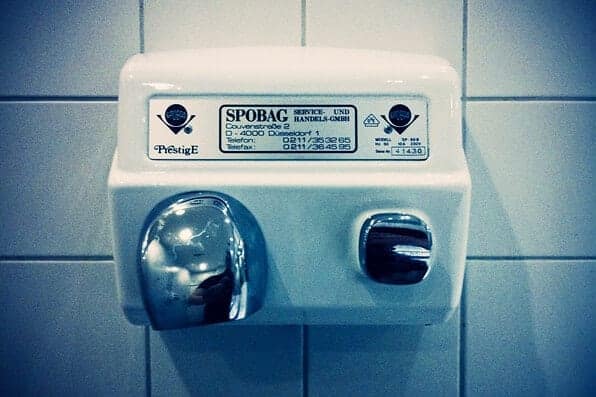Bathroom hand-dryers aren’t only expelling hot air. They’re unleashing a vortex of bacteria-laden vapors that may leave your hands, clothing and other body parts soiled with disease-inducing bugs.
Hand-dryers, it turns out, pick up miniscule fecal matter after a toilet is flushed and disperse the bacteria not only around the bathroom but into adjacent rooms as well, according to a new study appearing in the journal Applied and Environmental Microbiology.

Researchers from the University of Connecticut School of Medicine tested their own public restrooms for the study, assessing the number of bacterial colonies found on sticky plates that they had stashed inside. After trips to the bathroom that didn’t include hand-dryer use, the bacterial colonies were sparse — about six per plate. But when the hand-dryers were spewing hot air, the colonies multiplied tenfold.
Among the bacteria wafting around the bathrooms were strains normally found in the human gut, including Staphylococcus aureus, a common cause of food poisoning, and Bacillus subtilis, a fellow occupant of the gastrointestinal system.
The researchers swabbed the hand-dryers to see if they contained bacteria, but their search came up with just a small portion of the number of colonies found on the sticky plates. Therefore, they surmised that a more complex give-and-take was at play, positing that the bacterial particles were sent airborne from the force of flushing toilets. The hand-dryers then acted like a hot-air delivery system, picking up the particles and dispersing them around the room.
Yet the team found that airborne bacteria that began a flight pattern in the bathroom didn’t end their trip there. High-powered hand-dryers were capable of sending the floating particles to external spaces, as well.
Related: Dirty Money – Cash Has More Disease-Causing Bacteria Than You Think
“Within a large building, potentially pathogenic bacteria, including bacterial spores, may travel between rooms, and subsequent bacterial/spore deposition by hand dryers is a possible mechanism for spread of infectious bacteria, including spores of potential pathogens if present,” write the study authors in Applied and Environmental Microbiology.
The researchers found that installing a HEPA filter over the hand-dryers was effective in reducing the amount of swirling bacteria, but it didn’t solve the problem entirely. The filters cut the bacterial counts four-fold, but “potential human pathogens were recovered from plates exposed to hand dryer air whether or not a HEPA filter was present and from bathroom air moved by a small fan,” they write.
While bacteria like Staphylococcus aureus are normal inhabitants of the human gut, coming into contact with them in the air or on a surface can lead to serious health problems. Staphylococcus aureus is the leading cause of infections to skin and can also result in dangerous bloodstream infections and conditions like pneumonia.
The findings may be a wake-up call to administrators in healthcare facilities, who may want to take a closer look at their bathroom design. “This study has implications for the control of opportunistic bacterial pathogens and spores in public environments including health care settings,” write the researchers.
Richard Scott is a health care reporter focusing on health policy and public health. Richard keeps tabs on national health trends from his Philadelphia location and is an active member of the Association of Health Care Journalists.


![How To: ‘Fix’ Crepey Skin [Watch]](https://cdn.vitalupdates.com/wp-content/uploads/2017/05/bhmdad.png)












